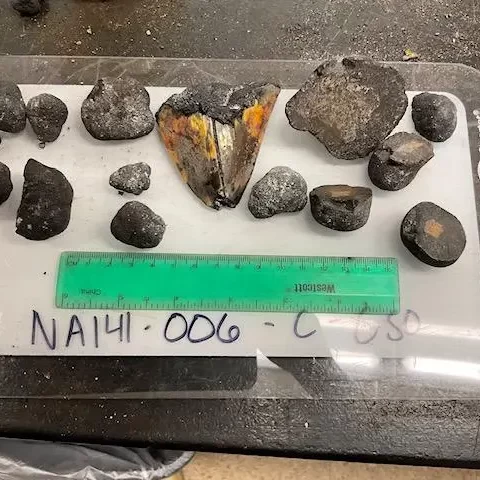Since the first Challenger Expedition, deep-sea explorers have recovered shark teeth from the bottom of the ocean. Sharks shed their teeth almost as much as Twitter sheds users after changing its name to the symbol synonymous with closing your browser. Shark teeth crop up in deepwater trawls, geologic samples, and even embedded in the core of polymetallic nodules. One famous polymetallic nodule collected during a 1978 expedition to the Clipperton-Clarion Zone featured a fossil great white shark tooth prominently protruding from the manganese-rich ore.
Finding shark teeth in samples dredged from the seafloor is a trivial matter, but spotting one in situ, sitting on the seabed, through the eyes of a robot hanging below you on a tether 3 kilometers long, is an entirely different experience.
That’s exactly what happened to the crew of the E/V Nautilus in June, 2022.
During an exploration of seamounts around Johnson Atoll in the Pacific Remote Islands Marine National Monument, researchers on the Nautilus live expedition spotted something exciting amidst the cobalt-rich crusts that comprise the hard bottom around these seamounts: an ancient megalodon tooth, partially wrapped in a blanket of manganese, sticking out of the bottom.

Manganese crusts grow slowly on the deep seafloor as metals from seawater accrete on the surface of hard structures: exposed rocks, ancient shells, and even the teeth of long extinct sharks. These crusts take millions of years to form, which means that this tooth was likely found where it fell, ejected from the mouth of a shark that went extinct 2.6 million years ago.
The ferromanganese crusts found on the Johnson Atoll and throughout seamounts in the Pacific Remote Islands Marine National Monument are rich in manganese, cobalt, and nickel (though not as rich as polymetallic nodule deposits to the north in the Clarion Clipperton Zone). These crusts accumulate over millennia, providing hard structure for the diverse and delightful animals that call seamounts home. Though other countries are currently looking into opening up their seabed to deep-sea mining, the ecosystems that fall within the marine national monument, is, for the moment, protected from mineral exploitation.

We still know precious little about the ecosystems of the deep-sea, particularly those that lie far from the charismatic habitats of hydrothermal vents, methane seeps, whale falls, and coral reefs. A new species of the bone-eating Osedax worm was recently discovered feeding on the pulpy insides of thresher shark teeth. Did Osedax once do the same to the discarded teeth of ancient megalodons swimming through Pliocene seas?
The open access paper First in situ documentation of a fossil tooth of the megatooth shark Otodus (Megaselachus) megalodon from the deep sea in the Pacific Ocean is available in the journal Historical Biology.
This wasn’t the only fossil the E/V Nautilus team found in the Pacific Remote Islands Marine National Monument. They also recovered an ancient beaked whale skull encrusted in manganese:
Southern Fried Science is free and ad-free. Southern Fried Science and the OpenCTD project are supported by funding from our Patreon Subscribers. If you value these resources, please consider contributing a few dollars to help keep the servers running and the coffee flowing. We have stickers.
Feature photo via Ocean Exploration Trust/Katherine Kelley

